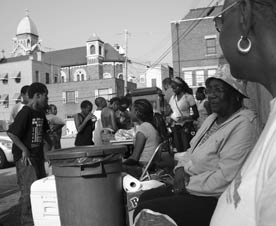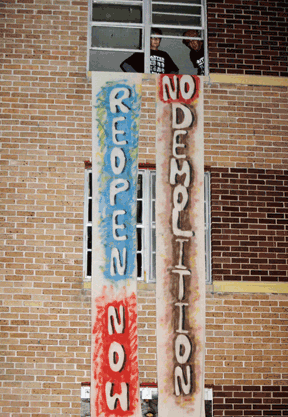On the Other Hand
But many residents, local business owners, and planners involved in the community’s own planning process don’t see it in such a rosy light. According to consultants from Pratt’s Center for Community Development, they see a functional working-class industrial neighborhood threatened with “wholesale removal” by an institution with a long history of encroaching on its neighbors. Despite its projected mixed uses and pocket parks, and promises that it will have no gates to keep the community out, the new campus will be a single-owner, mono-culture patrolled by a private security force and benefiting primarily outsiders, say local groups.
Opponents of the plan are driven by a big-picture fear of 1960s-style urban renewal, in which whole neighborhoods were lost to large-scale building projects, but they also have extensive and detailed specific criticisms of Columbia’s proposal, ranging from safety to gentrification:
- The site is located on a fault line and in an evacuation zone for hurricane surges and it will include labs that work with biohazards. Could a single massive connected bathtub space under the campus be constructed with adequate safeguards?
- The expansion will exacerbate an affordable-housing crunch and create displacement. Along with the direct displacement of a few hundred residents, including tenants of two city-owned buildings who have been working toward taking over as co-operative owners for the past four or five years, the expected indirect displacement is a source of much dispute and anger. Columbia acknowledges that some of this will occur, and in response has committed to building 1,000 units of university housing and funding a $20 million housing trust fund (with $10 million not to be committed until the second phase). However, this may not be enough. Community planners familiar with the project predict displacement on the order of three times Columbia’s estimates. For example, 3333 Broadway, a massive five-tower complex across from the development site, has already opted out of the city’s Mitchell-Lama moderate-income housing program. As a result, hundreds of previously affordable units are no longer protected by rent regulations.
- Jobs, demolition of historic properties (both those with landmark designations, such as the Sheffield Farms Stables, and those of significance to the neighborhood such as the current location of the famed Cotton Club), and additions to the environmental burdens of the neighborhood are also at issue. According to the Coalition to Preserve Community, a group of business owners and residents, about 1.5 percent of Columbia’s 14,000 employees live north of 125th Street in Community Board 9. If this percentage stays consistent, about 90 of the 6,000 promised university jobs would go to neighborhood residents. Given the community’s misgivings about the Columbia plan, it’s not surprising that many expansion opponents have connected with residents of two other New York neighborhoods where huge development projects — Atlantic Yards in Brooklyn and Willetts Point in Queens — have sparked backlash against the use of eminent domain.
Two Plans
Community boards in New York City can and do create their own land-use and zoning plans, called 197a plans, and CB 9 was already working on one when Columbia announced its intentions. The City Planning Commission, knowing the two plans were being developed at the same time, decided in an unprecedented move to consider them simultaneously, each in the light of the other.
This put the community planners in the unusual position of needing to develop their own alternative vision for the area Columbia was targeting, one much more specific than a 197a plan would usually entail. The community’s vision was a “mixed-use, mixed-ownership, predominantly academic uses” area that retained a manufacturing presence and still allowed Columbia to build its new campus on the land it already owns. Underground uses would follow Rockefeller Center’s model of interconnected basements. Their plan envisioned “a 24/7 live and work community, a sense of place, retention of the existing low- and moderate-income rental housing stock, and the continuation of current uses,” for one commercial corridor and a hub of arts and culture for another.
After reviewing Columbia’s plans, the community board made significant adjustments to the 197a plan to accommodate Columbia’s expansion: increasing the density allowed for community facilities, relaxing regulations for ground-floor use, and lining up their proposed district boundaries with Columbia’s.
However, there remained an overriding, apparently irreconcilable difference. The community board’s 197a plan is committed to a mixed-ownership area and an explicit prohibition on the invoking of eminent domain, while Columbia’s is committed to full site control, including asking the state to use eminent domain to transfer ownership of both holdout commercial properties and publicly owned under-street areas to the university.
An Advantage and a Disadvantage
The commission’s decision to consider the plans together had pluses and minuses. The community had to wait a year and a half after the plan was completed for it to be considered, which, according to Mercedes Narciso, a senior planner from Pratt, was unfair. She believes it could have been approved, and then Columbia’s plan evaluated in light of those guidelines. On the other hand, historically 197a plans have been ignored in the face of large attractive proposals like Columbia’s, notes Ron Shiffman, another Pratt consultant. This time, the community’s vision was on the table at the same time as Columbia’s version.
But in the end, the City Planning Commission chose Columbia’s vision. On Nov. 26, 2007, the commission passed both the community’s 197a plan and Columbia’s rezoning proposal, but it removed from the 197a plan the portion dealing with the acreage Columbia wants. On Columbia’s plan, the commission scaled back the size and number of several of the research buildings. There was one vote against Columbia’s proposal, and one abstention; the modified 197a plan passed unanimously.
“To have the 197a plan approved is a great victory,” says Narciso. But the “twisted results” of approving them both will be that “all the amenities are going to be for a community that no longer lives there. It’ll be for the Columbia community.”
In comments to the planning commission’s report, CB 9 representatives note that while the community’s larger plan was approved, the section concerning Manhattanville was turned down on the basis of not providing as much space as the university said it needed; when the commission chose to reduce the amount of academic and research space based on their own “aesthetic values,” Columbia accepted the change without a peep. This, in their opinion, shows that Columbia never negotiated in good faith with the community board and that the planning commission relied too heavily on Columbia’s assessment of the 197a plan.






Comments